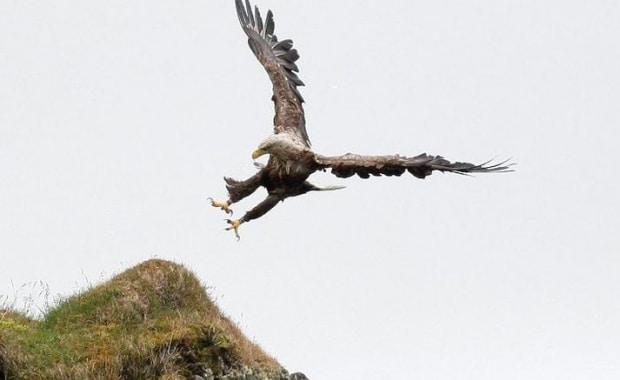White-Tailed Sea Eagle – (Haliaeetus albicilla)
The white-tailed sea eagle, once teetering on the brink of extinction in Iceland, has staged a remarkable comeback, defying the odds and captivating the hearts of those fortunate enough to encounter this majestic bird of prey. In the 1960s, a mere 20 mating pairs remained in the country, a dire situation largely attributed to hunting, with bounties on their feathery heads until as late as 1905. This relentless pursuit saw their numbers dwindle to fewer than 100 eagles, pushing them to the brink of oblivion.
More recently, another grave threat emerged as these eagles often fell victim to poisoned meat intended to target foxes. The poisoning of foxes was a common practice, and eagles, in their role as scavengers, ingested the deadly toxins. However, hope arose when Iceland took a crucial step in conservation by outlawing poisoning in 1964. This decision, combined with the tireless efforts of The Bird Life Conservation Organization, has been instrumental in saving these incredible birds from the precipice of extinction.
Despite being a protected species since 1914, witnessing these awe-inspiring creatures in the wild remains a rare treat. Iceland is now home to approximately 250 white-tailed sea eagles, with the majority residing around the bay that separates the Westfjords from Snaefellsnes, the peninsular region north of Reykjavik. These eagles are unmistakably enormous, ranking as the fourth largest species globally. They stand nearly a meter tall, with the largest wingspan ever recorded reaching an impressive 2.5 metres.

As versatile feeders, white-tailed eagles, often affectionately referred to as Icelandic Sea Eagles, have a diverse diet. They hunt for rabbits, mink, various bird species, and fish. When it comes to hunting fish, they employ a mesmerizing technique, flying low over the water’s surface, slowing momentarily above their prey, and then swiftly snatching it with their powerful yellow talons. While they have a reputation for taking lambs, it’s essential to note that most lambs are consumed as carrion, further demonstrating the eagle’s role as nature’s cleanup crew.
We at Sea trips are very lucky to see these eagles out hunting fish and we have certainly noted the increase in their population.
During the harsh Icelandic winters, these formidable birds of prey require a daily intake of 200g to 300g of food to sustain themselves. However, this dietary demand significantly increases during the breeding season, when they are tirelessly rearing their young.
Remarkably, only a third of known eyries, the majestic nesting sites of these eagles, are currently occupied. Most of these eyries can be found in the western part of Iceland. As the eagle population steadily grows, young eagles are beginning to reclaim abandoned eyries, a hopeful sign of their resilience and recovery.
The resurgence of the white-tailed sea eagle in Iceland is a testament to the power of conservation efforts, legal protections, and public awareness. These magnificent birds, once on the brink of extinction, now grace Iceland’s skies and coastal regions, enriching the country’s natural heritage.
As we bear witness to this inspiring success story, it’s essential to recognize that the white-tailed sea eagle’s survival hinges on our continued commitment to preserving their habitats, safeguarding their environment from threats, and fostering a sense of stewardship for these remarkable creatures. In doing so, we ensure that future generations will have the privilege of sharing the Icelandic landscape with these iconic raptors, and of course it doesn’t hurt that we get to enjoy their majesty out on sea.
Iceland took significant steps to protect the White-tailed sea eagle and their habitats. In 1964, the country outlawed the use of poisoned meat, a crucial move that helped safeguard the eagles from this deadly threat. Additionally, The Bird Life Conservation Organization played a vital role in the conservation efforts, working tirelessly to protect and restore the White-tailed sea eagle population.
Despite the progress in their population recovery, only a third of known nesting sites, known as eyries, are currently occupied. Most of these eyries are located in the western part of Iceland. However, as the eagle population continues to grow, young eagles are beginning to reclaim old eyries, a promising sign of their resurgence and adaptability.
As we celebrate this inspiring success story, it’s essential to remember that the continued survival of the white-tailed sea eagle relies on our ongoing commitment to preserving their habitats and safeguarding them from environmental threats. By fostering a sense of stewardship for these remarkable creatures, we can ensure that future generations will have the privilege of sharing the Icelandic landscape with these iconic raptors, a symbol of resilience and hope in the face of adversity.

